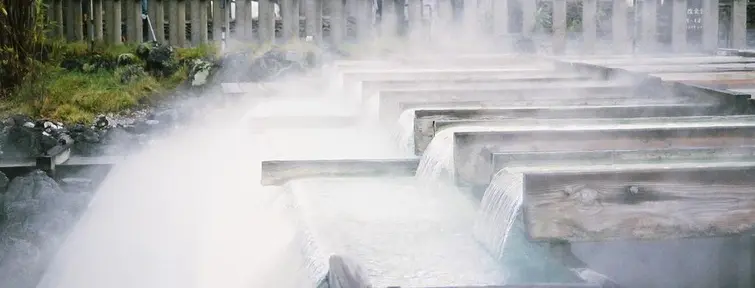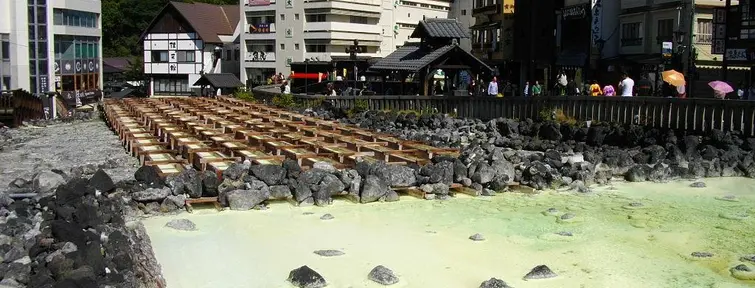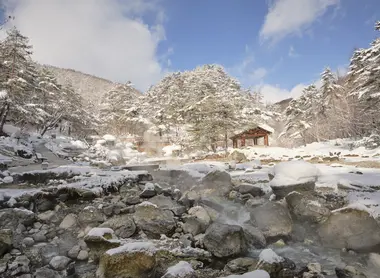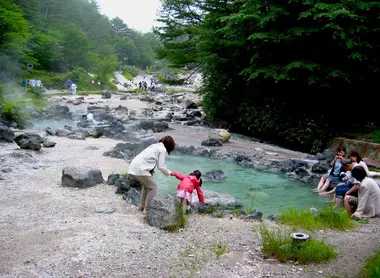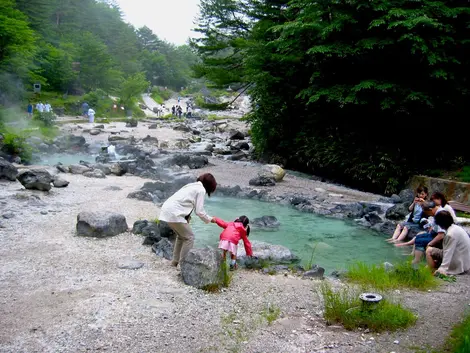Kusatsu Onsen 草津温泉
Favorite hot spring of the Japanese
Nestled in the picturesque mountains of Gunma Prefecture, Kusatsu Onsen is a rare gem among Japan's spas. One of Japan's most famous spas, it attracts hot-spring enthusiasts all year round.
Renowned for its sulfur-rich thermal waters, this destination offers much more than just a relaxing break - it's a real experience in the vibrant local culture and traditional atmosphere.
If you're an onsen enthusiast, be sure to visit the Kusatsu Onsen spa during your trip to Japan. If you've got a little time on your hands, the ideal place to spend the night is in a ryokan, a traditional Japanese hotel.
Unique charm steeped in history
The centuries-old history of Kusatsu Onsen dates back to the Edo period in the 17th century, when the area was discovered for its sulphurous hot springs, rich in curative properties. However, it was during the Meiji period in the 19th century that Kusatsu Onsen really began to attract attention as a popular spa destination.
Over the years, Kusatsu Onsen has continued to flourish as a wellness center, attracting visitors not only for its therapeutic benefits, but also for its traditional atmosphere and unique attractions. The town has survived the test of time, preserving its historic charm while adapting to the modern needs of travelers. Today, as visitors explore Kusatsu's cobbled streets and immerse themselves in its renowned thermal baths, they experience the traditions of yesteryear, embodying the evolution of a small hot spring hidden in the mountains into Japan's iconic spa destination.
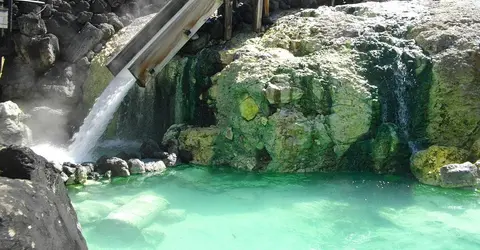
Kusatsu Onsen
Abasaa
Kusatsu thermal baths: benefits and cultural ceremonies
Onsen are a veritable institution for the Japanese. These hot-water baths are known for their many benefits for the body. Along with Arima Onsen (Hyogo prefecture) and Gero Onsen (Gifu prefecture), Kusatsu Onsen is one of the three hottest springs in Japan. Its temperature ranges from 51 to 94°C.
Kusatsu Onsen is renowned for the sulfurous thermal waters that gush forth from its natural springs, creating a veritable elixir for health and well-being, thanks to the unique composition of these waters, loaded with sulphur and other minerals. The benefits of this spring water were recognized by Erwin von Baelz, the German physician to Japan's imperial family who contributed to the development of Western medicine in the archipelago during the Meiji era (1868-1912).
What healing properties?
Kusatsu's thermal waters are celebrated for their healing properties, particularly in the treatment of skin ailments, rheumatism and circulatory problems. Visitors can immerse themselves in indoor and outdoor baths, allowing nature's bounty to revitalize body and mind.
The city is home to a wide variety of public baths, each with its own unique atmosphere. From more traditional baths to modern facilities, visitors can choose from a variety of options, each offering a different experience of Kusatsu's thermal waters.
Nearby: Manza Onsen
The Yubatake, the city's main attraction
At the heart of this sulphur-scented spa town lies Yubatake, literally "hot water field", a wooden structure that controls the cooling of the particularly hot, acidic water from the Kusatsu Shirane volcanic mountain that feeds the Kusatsu hot springs. It is built to allow the hot water to flow over a series of wooden platforms, creating a spectacular waterfall. This waterfall helps to cool the water, which then irrigates the 18 onsens in the town at a temperature more suitable for thermal baths.
Kusatsu Onsen boasts the highest water flow in Japan, at 32,300 liters per minute. This incredible flow is due in part to the fact that the town is fed by over 100 water sources.
Yumomi, when traditional rites come to the onsen
Yumomi is a traditional Japanese method of cooling hot spring water at Kusatsu Onsen to a temperature more comfortable for public bathing. As such, the Yumomi ceremony is both a spectacle for visitors and an important aspect of the preservation of traditions at Kusatsu Onsen.
The women are in charge of the Yumomi ceremony. Stationed around the pool, they dress in beautiful kimonos and use 1.80m-long wooden boards called yuoke to stir the hot water in a graceful circular motion. The wooden boards absorb the heat of the hot water, gradually cooling the temperature. During the ceremony, participants sing local folk songs called "Yumomi Uta". These songs add a cultural dimension to the ceremony, and are often passed down from generation to generation.
Yumomi adds an authentic dimension to Kusatsu baths and is often performed in public, offering visitors an immersive cultural experience. Some establishments in Kusatsu organize regular Yumomi shows (30 minutes) to enable visitors to participate in or observe this tradition in action.
See also: Onsen, a guide to good manners
What to see and do in Kusatsu Onsen: Main Attractions
Netsunoyu : Open-air baths
If the Yubatake is an iconic site at Kusatsu Onsen, the Netsunoyu, or open-air bath, offers another unique bathing experience in the heart of the spa. These atmospheric baths allow visitors to bask in the thermal waters while admiring the region's mountain panoramas.
Ashiyu : Open-air foot baths
Nearby the Yubatake is a foot bath called Yubatake Yukemuri-tei. A faithful reproduction of a public bath from the Edo period (1603-1868), this footbath is open 24 hours a day. A delight when you've spent the day exploring the city and its surroundings. Ashiyu are often designed with special liners on the bottom to gently massage the feet while absorbing the benefits of the minerals present in the thermal water. The relaxed ambience and natural surroundings help to create an inviting place to relax, with a privileged view over the Hot Water Field.
Downtown charm and culinary specialties
The Yubatakedori shopping street offers picturesque boutiques and charming wooden restaurants. With the scent of Yubatake particularly visible in winter, this bustling street of local stalls creates a living canvas where local culture is revealed through traditional crafts, local produce and the warm hospitality of the locals. Stop for a moment to sample the local specialty, Kusatsu soba. Prepared from local buckwheat, the noodles boast a distinctive flavor. Served hot or cold, they are often garnished with local condiments such as spring onion or grated daikon. In the main square, you'll find an excellent soba with all-you-can-eat tempura!
You can also try other specialties such as Kusatsu Tofu, Kusatsu Manju, Sansai Soba, Gyusiji Curry Udon, or Yunohana Gozen, a traditional meal served in the ryokan of Kusatsu Onsen.
The ideal way to spend the night when visiting the beautiful town of Kusatsu is in a traditional Japanese hotel, a ryokan. Choose a Japanese-style room with tatami and futon, and perhaps even a private bath, for a guaranteed trip to the heart of Japanese cultural tradition. We recommend the Kusatsu Hotel, which offers a wonderful experience!
During your visit to Kusatsu, you can discover the Sulfide Museum, which offers a fascinating insight into the local geology and the therapeutic benefits of Kusatsu's thermal springs. Alternatively, you can indulge in open-air cultural workshops, weather permitting, such as pottery sessions or traditional handicrafts. You'll take home a wonderful souvenir made with your own hands, and above all, you'll have a wonderful experience at the heart of traditional Japanese culture.
To find out more: 10 outdoor activities in Gunma
Getaways around Kusatsu Onsen
Nestled in the Japanese Alps, Kusatsu Onsen offers a beautiful backdrop to the surrounding mountains. These include Mount Shirane, an imposing volcano offering hiking trails with breathtaking views. You can also try climbing Mount Yumomi, with its panoramic views of the region. You may be lucky enough to spot a deer or Japanese monkeys on your walk.
Finally, not far away is the city of Nagano, capital of the Japanese Alps and renowned for its ski area. Every winter, skiers flock here to hurtle down the slopes of the Tenguyama and Honshiranesan mountains. Every summer, hiking trails open up on these mountains for nature-lovers.
An opportunity to make the detour from Kusatsu Onsen (1h30 to 2h transport time)!
Related : The best hikes in the Japanese Alps
